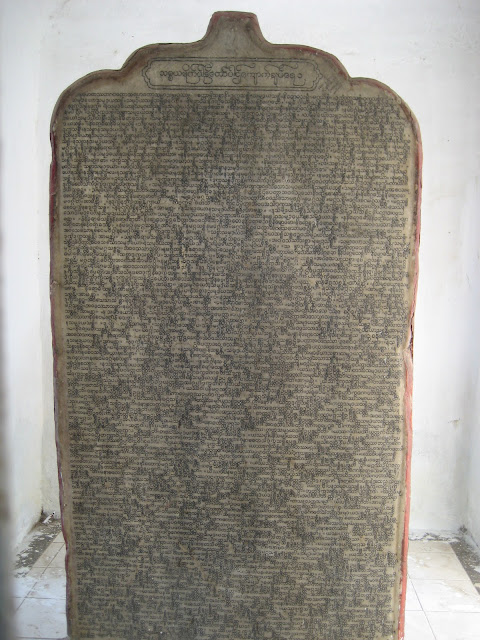 |
| The Kuthodaw Pagoda viewed from the southeast. |
Last November I wrote about the world’s largest book – Bhutan: A Visual Odyssey Across the Last Himalayan Kingdom – which holds the Guinness World Record. However, there is an older “book”, albeit not on paper. With "pages" much the same size, it is inscribed on marble and was finished in 1868. One can see it at the Kuthodaw Pagoda in Mandalay.
 |
| The complex at the foot of Mandalay Hill. |
Mandalay is in Myanmar, the Asian country once known as Burma. The Kuthodaw Pagoda is a stupa, which is a domed edifice that contains Buddhist (or sometimes Jain) relics. This stupa is 188 feet high and is modeled on another one in Myanmar, the Shwezigon Pagoda near Bagan, which is the prototype for Burmese stupas and was built in 1102 CE.
“Kuthodaw” means “royal merit”, and gaining merit is of importance to Buddhists. Someone can do that for themselves or for others, and one way is to build something significant. Mindon Min was the penultimate ruler of Myanmar, and one of the most popular and revered kings. He had the pagoda complex built at the foot of Mandalay Hill as part of the foundation of the new royal city of Mandalay in 1857. He wanted to leave a work of great merit that had serious relevance to Buddhists. So he took on a monumental project.
The Kuthodaw Pagoda complex contains 730 small structures, called kyuksa gu (meaning “stone inscription cave” in Burmese), each housing a marble slab. (Although you will often read there are 729 of them, there is an additional one on the southeast corner.) Each marble slab is inscribed on both sides with the entire Tipitaka Pali canon. This is the standard collection of scriptures in the Theravada Buddhist tradition written in the Pali language. It is the only complete early Buddhist canon. Originally composed in India, it was handed down orally until 29 BCE, when it was written down at the Fourth Buddhist Council in Sri Lanka.
Each marble slab is 3.5 feet wide, 5 feet tall, and 5 inches thick. The marble was quarried 32 miles away and transported by river to the site. There are 80 to 100 lines of text on both sides of each slab. Scribes carefully copied the text on the marble for the stonemasons, who chiseled it out and originally filled it in with gold ink. It took a scribe three days to copy text on both sides of the slab, and the stonemasons could finish up to 16 lines a day. It took almost eight years to complete the marble slabs. 729 of them contain the Tipitaka, and the 730th slab has text recording how it all came about.
The entire complex had gold overlay and jewels for decoration. When the British invaded, they vandalized the buildings and images, and looted the gems and other valuables. After a successful petition to Queen Victoria, the troops were withdrawn from religious sites. Restoration began in 1892 with a group that included members of the royal family. King Mindon Min had died in 1878, but it was tradition for relatives of the donor to be involved in repairs. The repair committee also included senior monks, and former officers of the king. The public participated as well. The complex was never restored to its former glory, however. The gold letters on the marble slabs were covered in black ink, which made it easier to read.
In 1900 a print copy of the Tipitaka Pali canon was published in a set of 38 volumes in Royal Octavo size of about 400 pages each in Great Primer type. The publisher was Philip H. Ripley of Hanthawaddy Press. He was an Armenian born in Myanmar and brought up in the royal court. He claimed that his production was true to the text on the marble slabs.
***************
Images courtesy of Wikipedia.
*******************************





Hello I know the comment now comes a bit late but I believe Philip H. Ripley was British not Armenian :)
ReplyDeleteI'm fairly certain of it :) Cheers ~
He may have been British as well (as his name implies!) but several of my sources claim that he was Armenian, including page 2 of this one:
ReplyDeletehttp://www.docstoc.com/docs/91885912/World_27s_largest_book
I thank you for your time and comment!
Philip H. Ripley was my great-grandfather, and yes, he was born in Rangoon, Burma in 1858. I am currently research my family history and if you have information on Philip H. Ripley's ancestors, where they were from etc. I would very much appreciate you contacting me.
ReplyDeletedsripley@gmail.com
Thank you.
Hello, David, I don't any info on P.H. Ripley, but if I ever come across anything I will let you know. I think he and Hanthawaddy Press would make an interesting book. Good luck!
ReplyDelete